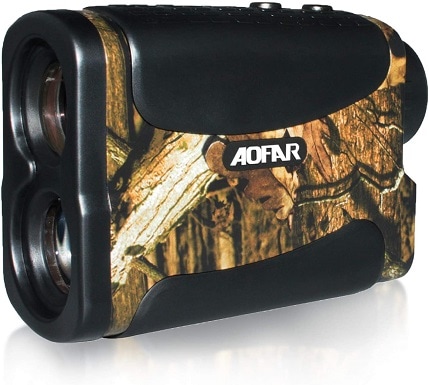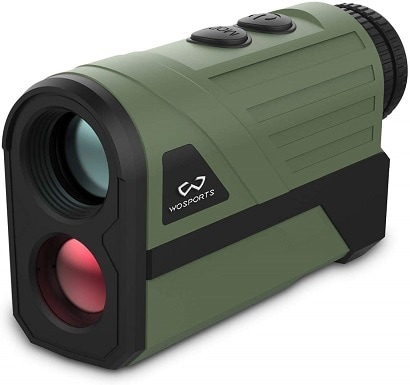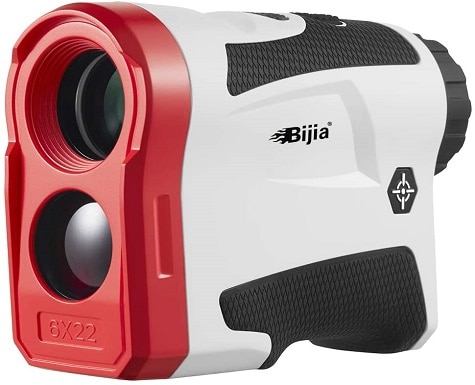10 Best Budget Rangefinders of 2025 – Reviews & Top Picks
Last Updated on

Rangefinders can be an invaluable asset, giving you useful data that helps you take the perfect shot on your hunt. The problem is that a bad rangefinder is worse than useless—providing inaccurate information that actively hinders your efforts.
Unfortunately, the best products are often put behind a fairly steep paywall. Is it even possible to get a good rangefinder on a budget? After months of research, we can answer that question with a definitive yes!
The 10 products found below all specialize in providing you with the ideal combination of performance and value. Read on for some budget rangefinder reviews!

A Quick Comparison of Our Favorites
| Image | Product | Details | ||
|---|---|---|---|---|
| Best Overall |
 |
TecTecTec ProWild Hunting Rangefinder |
|
CHECK PRICE |
| Best Value |
 |
Halo XL450-7 Laser Rangefinder |
|
CHECK PRICE |
| Premium Choice |
 |
Simmons Hunting Laser Rangefinder |
|
CHECK PRICE |
 |
AOFAR AF-700L Hunting Archery Rangefinder |
|
CHECK PRICE | |
 |
TACKLIFE MLR01 Laser Rangefinder |
|
CHECK PRICE |
The 10 Best Budget Rangefinders – Reviews 2025
1. TecTecTec ProWild Hunting Rangefinder – Best Overall

The TecTecTec ProWild benefits from a pretty massive distance range. The laser finder can read distances up to 540 yards in length. It utilizes a “continuous scan mode” to constantly take data at rapid speeds. Consequently, your information is always there when you need it, free from the lags that can kill the momentum of your hunt. Measurements are certified as accurate to within a yard.
The optics are also surprisingly good for a rangefinder of this price range. The lens is multilayered and does an excellent job of showing vivid colors. The lens is also where you collect your data. Each reading is displayed directly over your target.
Finally, the overall build design is optimal for the hunt. It’s lightweight at just 10 ounces and shouldn’t struggle to fit in most pockets.
Unfortunately, it is worth mentioning that low-light scenarios will be a real problem for the ProWild. In all other categories, though, the TecTecTec performs admirably.
- 540 yards of visibility
- Continuous scan mode
- Very accurate
- Quality optics
- Lightweight build
- Struggles in low light
2. Halo XL450-7 Laser Rangefinder – Best Value

The Halo has been deemed our best budget rangefinder for the money. With the lower price, you do see that some of the features are downgraded relative to other products. However, the stats on the Halo still look pretty good.
It features a 450-yard range and is certified as accurate give or take 3 feet. The eyepiece is also adjustable, allowing you to magnify your viewing range by 6X. This gives you the ability to take a detailed look at the animal you are pursuing, while also scanning the terrain.
The product comes with a battery, which is estimated to last a year under normal conditions. It also benefits from a scan mode, allowing you to take in data on several targets at once. This information is then displayed directly on the lenses.
Finally, it is also very lightweight, weighing just 7 ounces.
Unfortunately, the Halo depends on ideal conditions to deliver the best readings. On a beautiful day in flat, clear terrain, it should be fine. However, if it’s cloudy, or your environment is complicated by foliage or inclines, it becomes much trickier to collect data.
- Great price
- Lightweight
- Decent range
- Accurate
- Good battery
- Needs good conditions for accurate readings
3. Simmons Hunting Laser Rangefinder – Premium Choice

The Simmons comes in as a slightly higher-end piece of equipment. Versatility is one thing it really nails, providing accurate readings from as close as 10 yards, or as far away as 600. Data is displayed on a crisp LCD screen. The lens can also be magnified 4X for better viewing at those longer distances.
There is much to be said for the housing of this product as well. It’s very sturdy and made to resist water and fog. While it may not survive a lake dive, it shouldn’t struggle too much with a little bit of rain.
Users have reported that the laser often fails to pick up distances on darker animals (bears, goats, turkeys, etc.). Measurements can sometimes still be taken, but usually at much slower speeds.
- 10-600 yard range
- 4X viewing lens
- Sturdy housing
- Water/fog resistant
- Struggles with darker animals
4. AOFAR AF-700L Hunting Archery Rangefinder

The AOFAR AF-770L Hunting Archery Rangefinder can take measurements from 700 yards out. Fog and speed mode help you to remain accurate even against bad weather or particularly swift beasts, while the 6x lens is great for getting a detailed look at your terrain. Like most rangefinders, it features an accuracy rating of plus or minus one yard.
It also benefits from a continuous scan mode that allows the rangefinder to constantly search for data, ensuring measurements will be ready when you need them.
The exterior is waterproof and resistant to dust infiltration. Unfortunately, the exterior is also a bit bulky. It can be a little burdensome to haul around, but the otherwise high-quality performance may leave you willing to give it a try anyway.
- Massive range
- Fog, speed, continuous scan modes
- 6Xmagnification lens
- Dust resistant
- Waterproof
- A little difficult to move around with
5. TACKLIFE MLR01 Laser Rangefinder

The Tacklife MLR01 features a truly enormous range of 900 yards, while the lens can be magnified 7X for great long-distance viewing. The lens also benefits from a specialty coating that is designed to enhance the viewing quality.
Through 4 different modes, the Tacklife is well equipped for handling most situations, including angled measurements, speed readings, vertical height, and straightforward shots. Modes can be easily navigated with a single button, ensuring that you’ll never have to fiddle for too long in the heat of the hunt.
The unit is rechargeable through a USB port and can take 30,000 readings per charge.
Unfortunately, users do complain that it is very difficult to take measurements of your intended target. They report that the laser instead often takes data on trees or branches behind the target, making it difficult to properly plan a shot.
- 900-yard range
- 4 different modes
- Great battery
- 7X magnification
- Difficult to lock onto the intended target
6. Gogogo Sport Laser Rangefinder

The Gogogo differs from other options we’ve seen to this point in that it tailors it features equally for hunters and golfers. You can certainly take distances on animals, and other key locations on a hunt, but many of the Gogogo’s features favor the golf course setting.
It uses a “jolt technology” to vibrate when you lock on a flagstick and can measure course slope for easier club selection. Incidentally, the slope modes may also benefit hunters who are viewing a target from an incline.
The lens is coated to prevent glare and can be magnified 6X. It features a range of 650 yards and is accurate to within plus or minus one yard of the reading you are given.
Unfortunately, the speed of this laser rangefinder isn’t so great for hunting. It may take close to 10 seconds to get a reading, which may not mean much in golf, but can make a huge difference when stalking a target.
- Good for hunting and golf
- Slope measurements
- 650-yard range
- 6X lens
- Speed may be too slow for hunting
7. Wosports Hunting Rangefinder

The Wosports rangefinder can view anywhere from 650-1000 yards out, and benefits from a 6X magnification lens. The manufacturer claims that readings are adjusted for even the smallest environmental factors, including moisture, wind, and fog.
The big problem here is value. It’s approximately the same price as most of the other units on our list but is ultimately lacking in special features. It doesn’t measure angles or inclines and struggles to lock onto specific targets. Though still a solid product, it may help to remember that you can get more for roughly the same amount of money elsewhere.
- Great range
- Accounts for wind and fog
- 6X
- Value concerns
8. LaserWorks PRO X7 Golf Rangefinder

Laserworks is another option that puts the emphasis on golf. It features a “pinsensor” that will notify you with a jolt when you’ve locked onto the flagstick and slope measurements for easier club selection. And of course, slope measurements can also benefit the hunter viewing targets on hilly terrain.
It’s also rechargeable, connecting wirelessly to the charging base. The Laserwork’s battery can be fully juiced up in 3 hours or less. One charge should be good for approximately 8000 measurements.
The Laserworks can measure vertically, horizontally, and for speed, which are all features that will empower the hunter, and has a maximum range of 656 yards.
Finally, the body of the rangefinder is also very sturdy. The exterior itself is tough, and it has been sealed to protect against rain or dust.
The biggest complaint is that the Laserworks provides the occasional wild inaccuracy. For example, you may receive a reading of 350 yards when it is visually apparent that you aren’t more than 50 yards from your target.
Unfortunately, inaccuracies of this nature may then cause you to doubt reliable readings, leading to further problems.
- Good golf features
- Slope measurement
- 656-yard range
- Very sturdy
- Occasionally glitches with wildly inaccurate readings
9. PEAKPULSE 7S Golf Rangefinder

The Peakpulse has plenty to offer golfers, but not so much to entice the avid hunter. Like most of the other golf-oriented rangefinders, it measures for slope and vibrates when you lock onto the pin. It also features a range of 300 yards and can be magnified 5x to get a better look at the green.
For the average linksman, these features should be more than satisfying. For the hunter, they don’t quite cut the mustard. The 300-yard range is probably less than most will be hoping for, and the processing speed also leaves something to be desired. Measurements can take a decent amount of time to show up (as long as 10 seconds on some occasions), giving your prey ample time to escape.
It’s certainly not a bad product, but make sure you’re well-acquainted with its strengths and weaknesses before deciding if this unit is right for you.
- Good golf features
- Slow processing speeds
- Distance range is fairly short
10. BIJIA Golf Rangefinder

Last but not least, the Bijia—another rangefinder with an emphasis on golf. It features a substantial range of 650 yards, and locks on easily to flags, confirming your aim with a vibration when you identify your target.
The unit measures at an average speed of less than one second and can adjust for slope—an advantageous feature for both golf and hunting.
Unfortunately, the problem with this product is that it regularly malfunctions. One moment it may be swift and accurate. The next, it may be slow and glitchy.
To make matters worse, it’s also one of the pricier products featured here today. Though still affordable by an industry-standard, there are definitely cheaper rangefinders available that don’t suffer these issues.
- 650-yard range
- Good golf features
- Sometimes very inaccurate
- Sometimes very glitchy
- Value concerns

Buyer’s Guide
Reeling from all of that new information? If so, you may stand to benefit from these handy buying considerations.
Maximum Yardage
Every rangefinder has its own maximum yardage—the highest distance it can accurately provide readings on. That number can range significantly from around 300 all the way up to 1,000. Only you can know how much yardage is right for your situation.
Still, it is generally better to error on the higher side. Better to have and not need, right?
Environmental Suitability
Naturally, a hunter’s rangefinder typically experiences a good deal of wear and tear. You want to make sure that the product you choose is up for anything you throw at it. Getting something that is waterproof, shockproof, and dustproof will help ensure that it survives even the most trying days on the hunt.
Golf?
Most of the products we looked at today are made for hunting. However, rangefinders are also used on the golf course. Players appreciate them for their ability to give accurate measurements to the green, and other key locations on the course.
Most of the rangefinders on our list can be used in the context of golf, but a few of them were specifically designed for it.
Rangefinders that are intended for golf are usually a little bit different. They may have slower loading times (golf, after all, is a game of waiting), or smaller yardage ranges.
They’ll probably also have golf-specific features. For example, some are specially designed to lock onto golf flags.
Bottom line? If you aren’t a golfer, you probably won’t want one with these features. However, people that golf and hunt may favor products tailored equally to both settings.

Optic Quality
The truth is that really high-end optical equipment generally costs a good deal more than any of the products featured here today.
Many of these products do still produce good visuals, but because we are looking at budget gear, you won’t have the same benefits of higher-end units. For example, many of these rangefinders struggle to pick up darker colors, and may not be able to produce readings in shadowy areas.
Typically, higher-end units don’t have those sorts of problems.
Processing Speed
Rangefinders don’t always advertise their processing speed. This is possibly because speed is subject to situational variables. For example, you might get lightning-fast reads on a flat, open field, but very slow readings in a shadowy wooded area.
Every once and awhile, manufacturers will list how fast their rangefinder is supposed to provide readings. Otherwise, it’s in your interest to check with reviews like this one. We mention when processing speed is slow because several seconds can mean all the difference when you are on the hunt.
Battery
Battery life is typically measured in how many readings a rangefinder can produce in between charges/new batteries. This number can actually be quite high, with some units producing tens of thousands of readings off of a single charge.
You will also want to consider what happens when the charge does run out. Do you have to buy a new battery? Or can your rangefinder be juiced up with a charger in a matter of hours?
Most people favor rechargeable products because they are more convenient. If the power source is important to you, pay close attention before making your buying decision.

Conclusion
Which of our budget rangefinder reviews spoke to you the most? If you still haven’t made up your mind, you may find it helpful to go back and revisit a couple of distinguished options from our list. Those that gravitate towards the best of the best, even when it means shelling out a couple more dollars to get it, will probably appreciate our top choice, the TecTecTec ProWild Hunting Rangefinder.
And of course, the whole point of this list is to find budget-friendly options, so we should also mention our best for the money pick, the Halo XL450-7 Laser Rangefinder.
Table of Contents
- A Quick Comparison of Our Favorites
- The 10 Best Budget Rangefinders – Reviews 2025
- 1. TecTecTec ProWild Hunting Rangefinder – Best Overall
- 2. Halo XL450-7 Laser Rangefinder – Best Value
- 3. Simmons Hunting Laser Rangefinder – Premium Choice
- 4. AOFAR AF-700L Hunting Archery Rangefinder
- 5. TACKLIFE MLR01 Laser Rangefinder
- 6. Gogogo Sport Laser Rangefinder
- 7. Wosports Hunting Rangefinder
- 8. LaserWorks PRO X7 Golf Rangefinder
- 9. PEAKPULSE 7S Golf Rangefinder
- 10. BIJIA Golf Rangefinder
- Buyer’s Guide
- Conclusion
About the Author Robert Sparks
Robert’s obsession with all things optical started early in life, when his optician father would bring home prototypes for Robert to play with. Nowadays, Robert is dedicated to helping others find the right optics for their needs. His hobbies include astronomy, astrophysics, and model building. Originally from Newark, NJ, he resides in Santa Fe, New Mexico, where the nighttime skies are filled with glittering stars.
Related Articles:
How to Clean a Refractor Telescope: Step-by-Step Guide
How to Clean a Telescope Eyepiece: Step-by-Step Guide
How to Clean a Rifle Scope: 8 Expert Tips
Monocular vs Telescope: Differences Explained (With Pictures)
What Is a Monocular Used For? 8 Common Functions
How to Clean a Telescope Mirror: 8 Expert Tips
Brightfield vs Phase Contrast Microscopy: The Differences Explained
SkyCamHD Drone Review: Pros, Cons, FAQ, & Verdict



